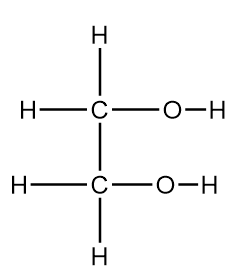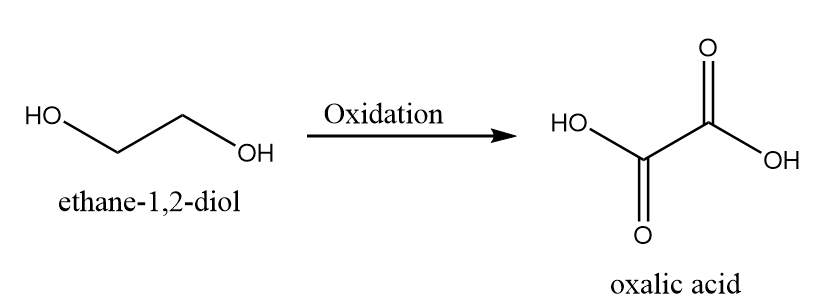
Ethane-1,2-diol has the given structure. Without breaking the

A.
B.
C.
D.

Answer
402.9k+ views
1 likes
Hint: In organic chemistry, the oxidation and reduction of compounds is described on the basis of addition and removal of hydrogen and oxygen atoms. During a reaction, if addition of oxygen atoms or removal of hydrogen atoms takes place then it is said to be oxidation reaction while if addition of hydrogen atoms or removal of oxygen atoms takes place then it is said to be reduction reaction
Complete answer:
For oxidizing alcohols, various oxidizing reagents can be used like chromic acid
1. When only one hydroxyl group is oxidized to aldehyde group:

2. When both the hydroxyl groups are oxidized to aldehyde group:

3. When one hydroxyl group is oxidized to aldehyde while other is oxidized to carboxylic acid:

4. When only one hydroxyl group is oxidized to carboxylic acid group:

5. When both the hydroxyl groups are oxidized to carboxylic acid group:

Hence, the total four aldehyde groups and four carboxylic acid groups are formed in the possible oxidation product.
Thus, option (D) is the correct answer.
Note:
It is important to note that in ethylene glycol, both the hydroxyl groups are attached to primary carbon atoms. That’s why the groups are oxidized to the aldehyde group. If in case, the hydroxyl group is attached to a secondary carbon atom, then it will be oxidized to the ketonic group.
Complete answer:
For oxidizing alcohols, various oxidizing reagents can be used like chromic acid
1. When only one hydroxyl group is oxidized to aldehyde group:

2. When both the hydroxyl groups are oxidized to aldehyde group:

3. When one hydroxyl group is oxidized to aldehyde while other is oxidized to carboxylic acid:

4. When only one hydroxyl group is oxidized to carboxylic acid group:

5. When both the hydroxyl groups are oxidized to carboxylic acid group:

Hence, the total four aldehyde groups and four carboxylic acid groups are formed in the possible oxidation product.
Thus, option (D) is the correct answer.
Note:
It is important to note that in ethylene glycol, both the hydroxyl groups are attached to primary carbon atoms. That’s why the groups are oxidized to the aldehyde group. If in case, the hydroxyl group is attached to a secondary carbon atom, then it will be oxidized to the ketonic group.
Latest Vedantu courses for you
Grade 11 Science PCM | CBSE | SCHOOL | English
CBSE (2025-26)
School Full course for CBSE students
₹41,848 per year
Recently Updated Pages
Master Class 4 Maths: Engaging Questions & Answers for Success

Master Class 4 English: Engaging Questions & Answers for Success

Master Class 4 Science: Engaging Questions & Answers for Success

Class 4 Question and Answer - Your Ultimate Solutions Guide

Master Class 11 Economics: Engaging Questions & Answers for Success

Master Class 11 Business Studies: Engaging Questions & Answers for Success

Trending doubts
Give 10 examples of unisexual and bisexual flowers

Draw a labelled sketch of the human eye class 12 physics CBSE

Differentiate between homogeneous and heterogeneous class 12 chemistry CBSE

a Tabulate the differences in the characteristics of class 12 chemistry CBSE

Why is the cell called the structural and functional class 12 biology CBSE

Differentiate between insitu conservation and exsitu class 12 biology CBSE




